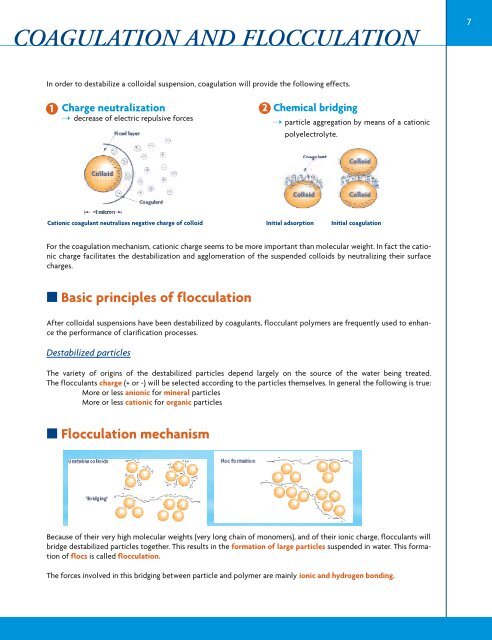DRINKING WATER - SNF Group
DRINKING WATER - SNF Group
DRINKING WATER - SNF Group
Create successful ePaper yourself
Turn your PDF publications into a flip-book with our unique Google optimized e-Paper software.
COAGULATION AND FLOCCULATION<br />
In order to destabilize a colloidal suspension, coagulation will provide the following effects.<br />
1 Charge neutralization<br />
➝ decrease of electric repulsive forces<br />
Cationic coagulant neutralizes negative charge of colloid<br />
For the coagulation mechanism, cationic charge seems to be more important than molecular weight. In fact the cationic<br />
charge facilitates the destabilization and agglomeration of the suspended colloids by neutralizing their surface<br />
charges.<br />
■ Basic principles of flocculation<br />
After colloidal suspensions have been destabilized by coagulants, flocculant polymers are frequently used to enhance<br />
the performance of clarification processes.<br />
Destabilized particles<br />
The variety of origins of the destabilized particles depend largely on the source of the water being treated.<br />
The flocculants charge (+ or -) will be selected according to the particles themselves. In general the following is true:<br />
More or less anionic for mineral particles<br />
More or less cationic for organic particles<br />
■ Flocculation mechanism<br />
2 Chemical bridging<br />
➝ particle aggregation by means of a cationic<br />
polyelectrolyte.<br />
Initial adsorption Initial coagulation<br />
Because of their very high molecular weights (very long chain of monomers), and of their ionic charge, flocculants will<br />
bridge destabilized particles together. This results in the formation of large particles suspended in water. This formation<br />
of flocs is called flocculation.<br />
The forces involved in this bridging between particle and polymer are mainly ionic and hydrogen bonding.<br />
7






